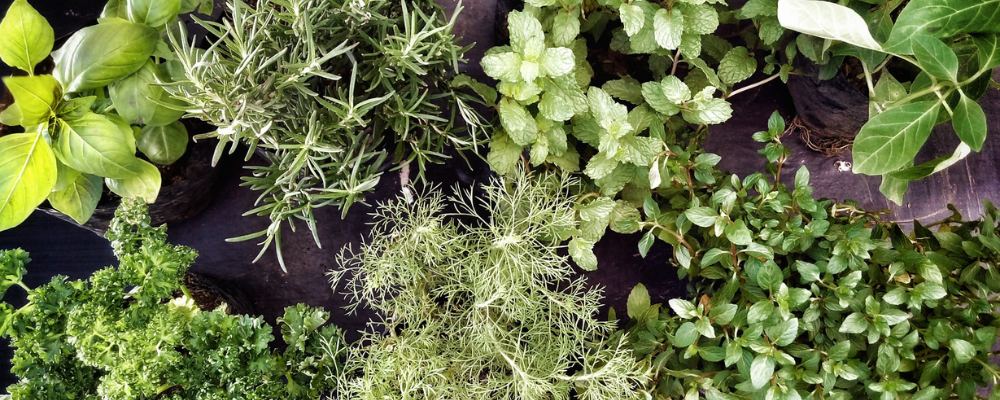Sense-Sational Herbs
Written by Jerry Parr and Carol Welch
Rosemary There are many reasons why a gardener finds pleasure in a healthy and beautiful plant. It may be a delight to the eyes, a wonderful fragrance to be enjoyed, a fresh flavor to be savored, a tranquil sound as the breeze passes by, or an interesting texture that intrigues the fingertips. While many types of gardens may delight a few of the senses, only the herb garden can appeal to them all.
Herbs make sitting in the garden a pleasure. Their fragrance is inviting and exciting. Rosemary can be planted where you can touch it as you walk by. It has a wonderful and relaxing aroma. Cut and dry the flowers of lavender to add sweet fragrance to indoor spaces. Enjoy the spicy scented leaves of curry on a warm, sunny day. Walk across a carpet of creeping thyme and enjoy a rich aromatic moment. Lemon and lavender thyme are my personal favorites. Give it a try, and you will discover your own. Maybe yours will be artemesia, marjoram, or lemon balm.
My favorite herb for flavor is oregano. Homemade pizza just wouldn’t be the same without it. In fact, I would say that there are five essential cooking herbs that every garden should have: basil, rosemary, oregano, thyme, and mint. Don’t be afraid to add others to the list. Many herbs blend well together so go ahead and experiment. There is nothing quite as satisfying as spicing up your dinner plate with a little home-grown pizzazz.
Catmint I find that some herbs are particularly soothing, like the soft leaves of lambs ear. The thick down on the leaves might easily be mistaken for the soft wool on the ears of its namesake. Jerusalem sage is another herb that is soft to the touch, but you get the added benefit of the light musky aroma of sage. Some of our more interesting herbs are actually healing to the touch. The juice of a plump aloe stem may soothe a burn, and the pulverized leaf of comfrey may ease the sting of insects.
Lamb’s Ear The wonderful blooms of herbs are a magnet to our eyes, but we aren’t the only ones attracted. The flowers of pineapple sage will put out a calling card to the hummingbirds in your neighborhood. The long-lasting, tubular red blooms are irresistible; to the hummingbirds that are a unique delight to the senses. Blooming herbs will also attract butterflies. Lavender, bee balm, chives, catnip and hyssop are filled with nectar that butterflies need in order to survive. Many popular herbs such as parsley, dill, fennel, and rue are also host plants for butterfly caterpillars. Female swallowtails will seek out these herbs to lay their eggs, so be sure to plant extra to feed their hungry babies.
St. John’s wort is a wonderful low-growing herb with graceful branches that provide interest and color in the spring and the fall. Springtime brings beautiful yellow blooms and the cooling temperatures in fall yield intriguing bronze foliage. The sunny blooms of calendula will catch your eye and brighten day. Their unique shades of cream, yellow, orange, and red will brighten the corner of any garden. Another characteristic that makes these herbs even more desirable is that they will actually repel some of the pests that feed on your plants. Consider them a natural insect repellant for your garden.

Herbs are easy to grow, needing very little care compared to other plants. Because of this, you can plant them anywhere. They may be combined into an herb garden or planted throughout the garden as companions for other plants. They may adorn a window box or a container garden. They may accent your evergreens, or provide a backdrop for your annuals. In my garden herbs are both versatile and indispensable.
Herbs generally require 6 hours of sunlight each day along with well-drained soil. It is helpful to add compost to the soil every year, and use fertilizer sparingly. Many of our herbs are hardy, native plants that need very little supplemental nutrients; and some will die if over-fertilized. Some herbs such as lavender, thyme and oregano like to be on the dry side, while others need more moisture. The water needs of herbs are important to consider when choosing a planting sight. Arrange the plants so that those with similar requirements are together. Use mulch to help maintain moisture in the soil and reduce the need for watering.
Because of their amazing attributes, herbs have been used for centuries. From the cooking pot, to the cosmetic jar, to the medicine cabinet they have been indispensable from generation to generation. So go ahead and spice up your garden with some sense-sational herbs, and enjoy the new energy they interject into your outdoor experience.
CAUTION: Although herbs have been used for centuries for their medical properties, we do not recommend the amateur practice of herbal medicine. Many herbs can be toxic if not properly prepared or if taken in excess quantities. Herbs such as comfrey that may be beneficial when applied to the skin, can damage the liver and lungs, and may cause cancer when ingested. In addition, some herbs have been banned by the FDA for use in certain herbal products.
